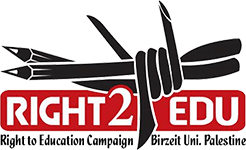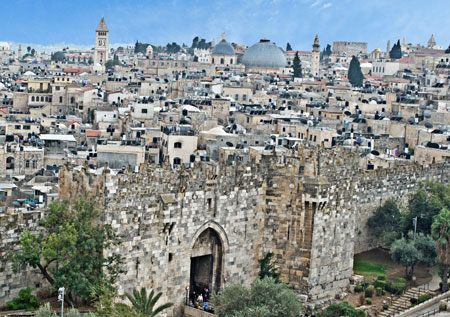Email: right2edu@birzeit.edu | Phone: 0097(0)2-298-2059
Ignored and occupied, East Jerusalem schools turn to international support
 |
| School children in Jerusalem |
Nine thousand Palestinian children living in East Jerusalem do not have a place in any of the four school systems operating in their community.
As the educational issues for East Jerusalem children reaches a crisis point, both the EU and a Jerusalemite community center have stepped up efforts to work within the existing system to ensure the right to education for East Jerusalem Palestinians.
The education system in East Jerusalem is complex, often mystifying, and local lobbying or international aid is only putting a small dent in the growing crisis.
The patchwork of ad hoc educational systems in East Jerusalem reflects the very status of Jerusalem as a contested area with Muslim, Christian, Palestinian, and Israeli interests affecting the fabric of life in the area.
In their efforts to improve the education of Jerusalemite children, the EU project has targeted the charitable/non-state school system, while the local community center has tried to fight for the civic rights of Jerusalemites within the Israeli Jerusalem municipal system.
The remarkably different strategies of the two efforts become clear when the real divisions between school systems are laid out.
Perhaps the oldest element of the Jerusalem education system are the church and charity schools. Funded mostly by international missionary money, they are teeming, ancient and falling down. Schools run by the UNRWA make up some of these numbers, others are Christian and provide religious education as part of their mission, and serve a population made up of 98% Muslims. Some of these are private schools, which charge high fees and are inaccessible to much of the population, though at least half of these are also in poor conditions. Together the church and charity schools serve about one quarter of the population of occupied East Jerusalem.
The Waqf schools are in a similar condition; overcrowded, poorly serviced and with a Muslim religious education. The schools are officially administered by the Islamic Waqf Foundation, which is unofficially affiliated with the Palestinian Authority (PA) and their special division on Jerusalem, which is not recognized by the state of Israel, which has annexed the area. These schools also serve about one quarter of the population of East Jerusalem.
Schools run by the Israeli Jerusalem municipal government, which provides services to the area and is obligated to under the fourth Geneva Convention, are in perhaps the worst condition of all. Israeli municipal schools serve about half of the registered school population of occupied East Jerusalem. The classrooms have on average 45 students each.
The crisis of education in East Jerusalem is one that is well documented and acknowledged by all parties. Israel, however, is evading its responsibilities to the residents of the area it has annexed. At the same time the PA is prevented from providing services in any direct way. Via the Waqf the Jerusalem division (based in Ramallah) can only govern curriculum and text books, since any changes to the physical structures of the school buildings would require permits from the Israeli municipality whose authority it does not recognize.
EU fills vacuum
On Tuesday afternoon the Saint Dimitri School celebrated the renovation and revitalization of its building alongside five other dilapidated schools in Israeli occupied East Jerusalem.
The program, called the Comprehensive School Upgrading Program, revamps the schools and upgrades the electricity networks, sanitation facilities, sewage systems, carpentry and mechanical works and general classroom conditions (paint, floors, and ceilings). It also funds new school equipment like computers, fax, and copy machines, as well as school management software.
In a recent report from the Association for Human Rights in Israel, the needs of Palestinian school children were outlined as follows: a critical shortage of classrooms, a lack of teacher training, poor facilities to accommodate the needs of a 21st century education (including science and technology equipment), unsanitary and unsafe classroom conditions in general, and a total lack of services for children with special needs.
The EU project, with its partners Save the Children Sweden branch and the Faisal Husseini Foundation, has done an exemplary job in providing the services that Palestinian children lack.
The project targeted eight schools in the Old City of Jerusalem and surrounding area, and beyond upgrading the facilities of five, with another three to go, provided extensive teacher training around teaching methods, interfaith education, inclusion and appropriate methods of maintaining discipline and openness in the classroom.
While the project did not look to the construction of new schools for the population to alleviate the critical shortage of classroom space, it did target three schools in the area that were actually under-populated. The Saint Dimitri School is one of them.
A private school that charges 2,500 shekels a year in school fees (663 US dollars) and is sponsored by the Patriarchate of the Greek Orthodox Church, the Saint Dimitri School might not have been an ideal candidate for receiving aid money to upgrade facilities.
As John John Kjaer, the Representative of the European Commission in Jerusalem, explained it however, the school offered a chance to increase the number of desks available to the children of East Jerusalem. In supporting the school, and even the salaries of the teachers through the EU’s PEGASE program, Kajer said that the project hoped they would be able to reduce their fees and make education in the private institution affordable and attractive for more families.
Any child that goes to Saint Dimitri because of the reduced fees would perhaps open up a space in one of the other local schools for a less well off student to go to.
While it’s a bit of a long shot, it seems this is all the EU funded project could do without expanding school buildings or breaking ground for new structures.
This option would require permission from the state of Israel.
Asked whether the mission of the project and its partner institutions to serve the needs of the Palestinian population of East Jerusalem through the betterment of essential services would be better served by putting pressure on Israel to take responsibility for the Palestinian “permanent residents” of occupied East Jerusalem, Kjaer could only say that the EU and EC were working on a “private dialogue” with Israel on the issue.
So while doing a fine job of developing creative solutions to ameliorate the crisis condition of education for Palestinians in East Jerusalem, the EU seems to be picking up Israel’s slack.
The PA is forced to work through back avenues to provide limited funds and services to Waqf schools in the area, and is prohibited from officially governing any part of the area that Israel annexed in 1967 and afterwards.
Local lobbying strong but looking for support
Efforts are being made by Palestinian organizations, like the Community Action Center of Al-Quds University in Jerusalem (CAC), at lobbying the Israeli municipality to make good on its promise (which it also made to the Israeli High Court) in 2007 to In March 2007, to build 400 new classrooms in East Jerusalem over the next five years.
As of the start of the 2008 school year, one new school had been constructed.
The situation has further been complicated as Israel continues to build the separation wall through the area of occupied East Jerusalem. Children of the Shu’fat Refugee Camp, who hold “permanent resident” status in Israel, saw their school land on the west side of the separation wall while their homes were mostly on the eastern side.
As a provisional measure the Jerusalem municipality gave the students an old market building, which had sold everything from groceries to goats, to call their school. The building, located next to a metal factory that releases noxious fumes during the day, was declared unsafe and the students and parents have gone on strike to protest the inhumane conditions.
The CAC organized a sit-in with the students of the school in front of the Israeli Jerusalem municipal buildings to protest the actions of the governor in denying them their right to a safe and healthy education.
The center has issued a call to the international community to visit the school provided for the children of Shu’fat camp, and are hoping that international organizations like the EU, Save the Children and the Faisal Husseini Foundation will help them put pressure on the Israeli municipal government, which is legally supposed to serve the East Jerusalem population.
More Articles
Under Israeli blockade of Gaza,...
Israel does not explicitly ban importing books to...




